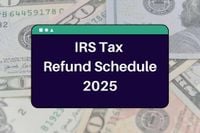As tax season 2024 approaches, millions of taxpayers are eager to find out when they can expect their IRS tax refund. Whether you’re filing your taxes early or waiting until the deadline, understanding the IRS tax refund schedule and the timeline for receiving your refund is essential for effective financial planning. In this article, we’ll provide a comprehensive guide on IRS tax refunds in 2024, explain key terms, and walk you through how to check the status of your refund. We’ll also offer practical tips to help you receive your refund faster.
Tax season doesn’t have to be stressful if you prepare in advance. With the right information and a little planning, you can ensure that your refund arrives on time. The IRS typically issues refunds within 21 days for e-filers using direct deposit, but paper filers take longer. Taxpayers claiming the Earned Income Tax Credit (EITC) or Child Tax Credit (CTC) may experience delays, with refunds beginning around mid-February 2024. Direct deposits are faster and typically received within 21 days, while paper checks can take 4-6 weeks.
Understanding the IRS Tax Refund Process for 2024 is crucial. The IRS handles millions of returns each year, processing them in batches and issuing refunds in various forms—direct deposit, paper check, or other methods. For 2024, the IRS refund schedule follows a similar timeline to previous years, but the specific refund dates depend on several factors, including how you file your taxes, whether you claim certain tax credits, and how you choose to receive your refund.
Key Factors Affecting Your IRS Refund Timeline:
- Filing Method: E-Filing vs. Paper Filing - E-filing is faster than filing on paper. The IRS can process electronically filed returns quickly, typically issuing refunds in 21 days if there are no issues. However, if you file a paper return, it can take the IRS 6 to 8 weeks to process your refund. To speed things up, the IRS recommends that taxpayers file their returns electronically.
- Direct Deposit vs. Paper Check - How you choose to receive your refund also impacts how quickly it arrives. Direct deposit is the fastest method for receiving a refund. The IRS can transfer the funds directly to your bank account, which typically happens within 21 days after the IRS accepts your return. Paper checks, on the other hand, are slower and can take up to 4-6 weeks to reach you.
- Tax Credits That May Delay Refunds - If you’re claiming certain tax credits, such as the Earned Income Tax Credit (EITC) or Child Tax Credit (CTC), expect a delay in receiving your refund. Due to anti-fraud measures, the IRS is required by law to hold refunds for taxpayers claiming these credits until mid-February. If you file early in January and claim one of these credits, your refund will likely be delayed until late February or early March.
Here’s what you can expect in terms of refund timing based on how and when you file your return:
Early Filers (Before February 2024) - If you file before the end of January and your return is simple, with no issues or claims for EITC or CTC, you could receive your refund as early as February 1, 2024. Direct deposit filers can expect their refund within 21 days of filing, while paper filers will face the typical 6-8 week delay.
EITC and CTC Filers (After February 15, 2024) - For taxpayers who claim the Earned Income Tax Credit (EITC) or Child Tax Credit (CTC), the IRS cannot issue refunds before February 15, 2024. After this date, refunds will begin to be processed, but you may not receive your refund until early March, depending on when your return was filed.
Filing on Paper - If you file a paper return, the IRS will likely take 6-8 weeks to process it and issue your refund. While e-filers might receive their refunds by early February, paper filers should expect to receive refunds closer to April 2024.
Once you’ve filed your taxes, you’ll likely want to know the status of your refund. Fortunately, the IRS offers several tools for checking your refund status:
- Where’s My Refund? - The Where’s My Refund? tool on the IRS website allows you to track the status of your refund in real-time. To use the tool, you’ll need to provide your Social Security number (SSN) or ITIN, filing status, and the exact refund amount from your tax return. The tool will show you whether your refund has been processed, when it was sent, and if there are any issues.
- IRS2Go Mobile App - For those who prefer mobile apps, the IRS offers the IRS2Go app, available for both iOS and Android. This app provides all the same features as the Where’s My Refund? tool, along with the ability to make payments, access your IRS records, and even check your refund status.
Want to receive your IRS tax refund faster? Here are some tips to help speed up the process:
- File Your Taxes Early - The earlier you file, the earlier you’ll receive your refund. If you’re ready to file and have all your paperwork, don’t wait until April. Filing by the end of January or early February can help you avoid processing delays.
- Opt for E-Filing - E-filing is the fastest way to submit your tax return. It’s also more accurate than paper filing, which can reduce the likelihood of delays due to mistakes.
- Choose Direct Deposit - When you choose direct deposit, your refund is automatically transferred to your bank account, making the process quicker and more secure. Paper checks can take up to 6 weeks to arrive in the mail.
- Double-Check Your Return - Errors on your tax return, such as incorrect Social Security numbers, missing forms, or incorrect deductions, can delay your refund. Use tax preparation software or a tax professional to ensure your return is error-free.
To avoid delays, here are some common mistakes taxpayers make that can hold up their refunds:
- Incorrect Social Security Numbers (SSN)
- Missing or Incorrect Forms
- Math Errors
- Omitting Income
- Choosing Paper Checks
In addition to direct deposit and paper checks, the IRS offers other options for receiving your refund, including prepaid debit cards and Refund Anticipation Loans (RALs). These options can provide quick access to funds but may come with additional fees.
With tax season in full swing, being informed about the IRS tax refund schedule can help you plan your finances better. Most taxpayers will receive their refunds soon, and understanding the process can alleviate some of the stress associated with tax season.






